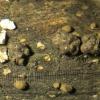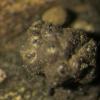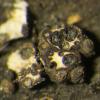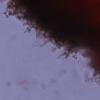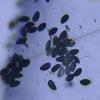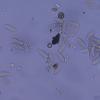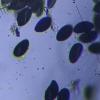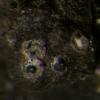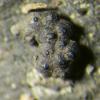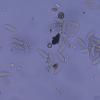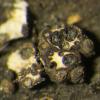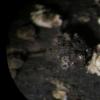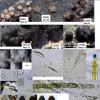
19-04-2024 14:28
Cudoniella tenuispora: Distinctive macro and habit

13-04-2024 11:44
 Riet van Oosten
Riet van Oosten
Hello, Found by Laurens van der Linde, April 2024

16-04-2024 17:43
 Giovanni ANTOLA
Giovanni ANTOLA
Bonjour,Trouvé sous paille humide, autour d'un je

17-04-2024 10:44
 Bernard CLESSE
Bernard CLESSE
Juste à côté du cône avec "Hyphodiscus ayelii"

16-04-2024 22:53
 Bernard CLESSE
Bernard CLESSE
Bonsoir à toutes et tous,Pourriez-vous m'aider à
A pyrenomycete (Xylariales) on bark of a fallen Acacia tree
Stephen Mifsud,
30-10-2019 05:29
 Material from Malta. The immature ascocarps consist of subspherical bodies with a dull olive green velvety indumentum maturing into a dark grey, nebular (cloud-) shaped fruiting body, about 3mm across. It is actually a cluster of perithecia with distinct black ostioles. My attempts to extract or see the asci from the chambers failed, but maybe from this data, the family or genus of the species can be suggested while I try to examine more material.
Material from Malta. The immature ascocarps consist of subspherical bodies with a dull olive green velvety indumentum maturing into a dark grey, nebular (cloud-) shaped fruiting body, about 3mm across. It is actually a cluster of perithecia with distinct black ostioles. My attempts to extract or see the asci from the chambers failed, but maybe from this data, the family or genus of the species can be suggested while I try to examine more material. However the spores are quite abundant, black 17-20um long with an interesting sinusoidal or curved germinal slit running diagonally along its length. This expands in 4% KOH and sometimes the perispore becomes lose and peels away.
Somewhat it reminds me to Hypoxylon.
Jacques Fournier,
30-10-2019 19:13

Re : A pyrenomycete (Xylariales) on fennel stalk
Hi Stephen,
yes likely a Hypoxylon and an interesting one. Is it soft, easy to cut or carbonaceous and brittle?
Try a KOH reaction by putting a little piece of the outer crust of a stroma in a drop of KOH and observe the pigments that are released, if any.
Please also try to find more stromata in good condition, with asci.
Good luck,
Jacques
Jaklitsch Walter,
31-10-2019 14:02
Re : A pyrenomycete (Xylariales) on fennel stalk
Hello,
your images remind me somehow of Xylaria sibirica. See Ju et al. (2009). Mycologia, 101(4), 2009, pp. 548–553.What´s the ascospore width and size of the hyaline conidia?
Best regards, Walter
Jacques Fournier,
31-10-2019 17:43

Re : A pyrenomycete (Xylariales) on fennel stalk
Hello Walter,
you are right, it is indeed a Xylaria, image 3 shows a white entostroma, thus it cannot be a Hypoxylon.
The spores might fit those of X. sibirica but the ostioles seem surrounded by a disc, which is not typical. Let's wait for further information.
Cheers,
Jacques
Stephen Mifsud,
01-11-2019 20:18

application of alkali (NaOH)
Good evening colleagues. I worked some more on this fungus and have some answers for you. I have applied 4% NaOH on immature and fully mature ascocarps.
The immature bodies changed from olive brown to dark olive brown without any change in hue. With water they got a bot darker too. Mature bodies changed from lead gray to dark gray (almost black), again no particular change in tone.
The immature bodies changed from olive brown to dark olive brown without any change in hue. With water they got a bot darker too. Mature bodies changed from lead gray to dark gray (almost black), again no particular change in tone.
Stephen Mifsud,
01-11-2019 20:40
Stephen Mifsud,
01-11-2019 20:57
Stephen Mifsud,
01-11-2019 21:09
Stephen Mifsud,
02-11-2019 02:31

And the bad news is...
Dear colleagues, the problem is that despite checking 4 or 5 fruiting bodies, I still couldn't find any asci. I don't know why maybe the specimen dried out, or the asci break up after maturity but it is strange that I can't find any. I don't have much material now and I wish to keep few intact for fungarium reasons. But I can try a last attempt.
I am slicing the ascocsrps transversal and put in NaOH plus glycerol solution or Congo red. I don't think these are destroying the asci.
I am slicing the ascocsrps transversal and put in NaOH plus glycerol solution or Congo red. I don't think these are destroying the asci.
Jaklitsch Walter,
02-11-2019 10:19
Re : A pyrenomycete (Xylariales) on fennel stalk
Well, the conidia are a bit shorter and broader and there is the disc around ostioles, just as you rightly noted, Jacques. It might therefore be an undescribed Xylaria, unless there is something hidden in the old literature; perhaps an African taxon.
Best wishes, Walter
Carmel Sammut,
02-11-2019 11:44
Re : A pyrenomycete (Xylariales) on fennel stalk
The specimens remind me of some collections I made. Collection CS484 was actually sent to Jacques but was still immature. This species seem to mature around May but often you cannot find it due to dry weather and/or insects.
The asci are difficult to find as they tend to squash easily so you must sauash gently removing the harder (unsquashed parts) manually and gently squashing again. Fresh specimens are always better.
The conidia size range are similar 8-10 x 3-4.4µm, spores 16-18 x 8-10µm.
My collection was not on fennel but on broadleaf branches but it looks like the same species.
Jacques Fournier,
02-11-2019 15:54

Re : A pyrenomycete (Xylariales) on fennel stalk
I don't remember well the collection CS 484 but one can see on your last plate that the surface is reticulately cracked, unlike that of X. sibirica and your last sample. it is usually a distinctive character but it may fade with age.
If they all do have similar ascospores with a spiral germ slit, it makes it a bit confusing.
To make progress I suggest you to carefully compare point by point your collections to X. sibirica as described by Ju et al. (2009) and to gather the results of your observations in a comparative table. This is the only way to show similarities and differences between them.
Cheers,
Jacques
Stephen Mifsud,
05-11-2019 07:01

Re : A pyrenomycete (Xylariales) on fennel stalk
Hi, Many thanks for your replies. Jacques, in a rather quick way, I already did what you suggested but I just lacked the data on the asci, so thanks to Carmel for his tips. When I checked the data I possess, characters do match with X. sibirica, except that the whole ascocarps are more isolated and not growing on bark.
So, I might try some a few more attempts to get hold of the asci under my microscope and will cross-check more meticulously to see if we can get a publishable record of X. sibirca from the Maltese Islands.
The cracked surface on Carmels' specimens and the white disc around the ostiole in my specimen is not reported in the X. sibirica protologue, although the image here shows that there is a bit of variation in that respect.
http://mycoweb.ru/Notes/Xylaria_sibirica.html
Thanks
So, I might try some a few more attempts to get hold of the asci under my microscope and will cross-check more meticulously to see if we can get a publishable record of X. sibirca from the Maltese Islands.
The cracked surface on Carmels' specimens and the white disc around the ostiole in my specimen is not reported in the X. sibirica protologue, although the image here shows that there is a bit of variation in that respect.
http://mycoweb.ru/Notes/Xylaria_sibirica.html
Thanks
